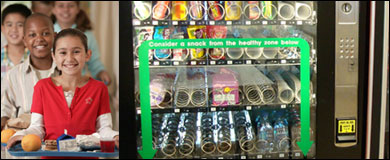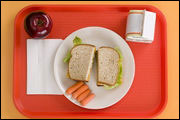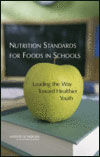Nutrition Standards for Foods in Schools: Leading the Way toward Healthier Youth
 The school environment is one of several settings that can influence children's food choices and eating habits. Schools can ensure that the available food and beverage options are healthy and help youth eat food that meets dietary recommendations for fruits, vegetables, whole grains, and nonfat or low-fat dairy products.
The school environment is one of several settings that can influence children's food choices and eating habits. Schools can ensure that the available food and beverage options are healthy and help youth eat food that meets dietary recommendations for fruits, vegetables, whole grains, and nonfat or low-fat dairy products.
Obesity has increased among school-age children and adolescents, which has put them at greater risk for other health concerns such as diabetes, hypertension, and cardiovascular disease. Inadequate diet and physical activity are contributing factors for childhood obesity.
 When it comes to America's youth, food choices and eating habits derive from many sources. Given the number of hours youth spend at school, school environments can have a significant influence on children's diets and play an important role in teaching and modeling appropriate healthy eating behaviors. Healthy diets (e.g., fruits, vegetables, whole grains, and nonfat or low-fat dairy products) contribute to the prevention of obesity and health concerns linked to obesity.
When it comes to America's youth, food choices and eating habits derive from many sources. Given the number of hours youth spend at school, school environments can have a significant influence on children's diets and play an important role in teaching and modeling appropriate healthy eating behaviors. Healthy diets (e.g., fruits, vegetables, whole grains, and nonfat or low-fat dairy products) contribute to the prevention of obesity and health concerns linked to obesity.
To provide schools with guidance on improving the foods and beverages offered, CDC conducted a study with the Institute of Medicine (IOM) to review and make recommendations about nutrition standards for foods and beverages offered in competition with school food service meals and snacks. The study resulted in a report entitled, Nutrition Standards for Foods in Schools: Leading the Way toward Healthier Youth.
Recommendations
In the report, IOM concluded that
- Federally reimbursable school nutrition programs should be the main source of nutrition in schools;
- Opportunities for competitive foods should be limited; and,
- If competitive foods are available, they should consist primarily of nutritious fruits, vegetables, whole grains, and nonfat or low-fat dairy products.
Schools can use the IOM recommendations to ensure that foods and beverages offered
contribute to an overall healthful eating environment.
Fact Sheet Series
 Using the findings of the Nutrition Standards for Foods in Schools report, CDC developed a set of four audience-specific fact sheets as a resource for school staff, parents, and youth to use to support and develop strong nutrition standards that will impact the health of students at school. These fact sheets answer commonly asked questions about the Nutrition Standards for Foods in Schools report and provide recommendations for implementing them.
Using the findings of the Nutrition Standards for Foods in Schools report, CDC developed a set of four audience-specific fact sheets as a resource for school staff, parents, and youth to use to support and develop strong nutrition standards that will impact the health of students at school. These fact sheets answer commonly asked questions about the Nutrition Standards for Foods in Schools report and provide recommendations for implementing them.
Understanding the Nutrition Standards for Foods in Schools fact sheets for:
- Parents, Guardians, Teachers, and School Staff (
 4 pages, 994KB)
4 pages, 994KB) - School Boards, School Districts, and Other School Administrators (
 4 pages, 935KB)
4 pages, 935KB) - School Food Service Personnel (
 4 pages, 950KB)
4 pages, 950KB) - Students (
 2 pages, 981KB)
2 pages, 981KB)
What You Can Do
 Learn more about the IOM's Nutrition Standards of Foods in Schools: Leading the Way toward Healthier Youth
Learn more about the IOM's Nutrition Standards of Foods in Schools: Leading the Way toward Healthier Youth  .
.- Use CDC's fact sheet series as a resource to help develop and support strong nutrition standards for food in schools.
- Review your school wellness policy to ensure the nutrition guidelines align with the IOM standards, ensuring that students have access to healthy foods like fruits, vegetables, whole grains, and low-fat or nonfat dairy during each school day.
- Examine the actual foods and beverages that are available to students—including competitive foods sold in cafeterias, snack bars, school stores, and vending machines—and determine if they meet the nutrition standards.
- Educate students about nutrition and offer and promote healthy food and beverage choices that meet the nutrition standards.
- Keep track of any improvements made and challenges encountered. Share improvements with parents and your school community.
- Help other school staff and parents identify foods and non-food options (e.g., stickers, small prizes) that might be best for classroom celebrations, classroom awards, school fundraisers, and other school-based activities.
More Information
- CDC's Healthy Youth! Nutrition page
- Nutrition Standards for Healthy Food in Schools Fact Sheet Series,
- CDC's Healthy Youth! Local Wellness Policies Tools & Resources for Schools
- The IOM Report, Nutrition Standards for Foods in Schools: Leading the Way toward Healthier Youth
 , is available for purchase in hardback and pdf versions or it can be read online for free.
, is available for purchase in hardback and pdf versions or it can be read online for free.
Current Features
Need info on a
different topic? See


